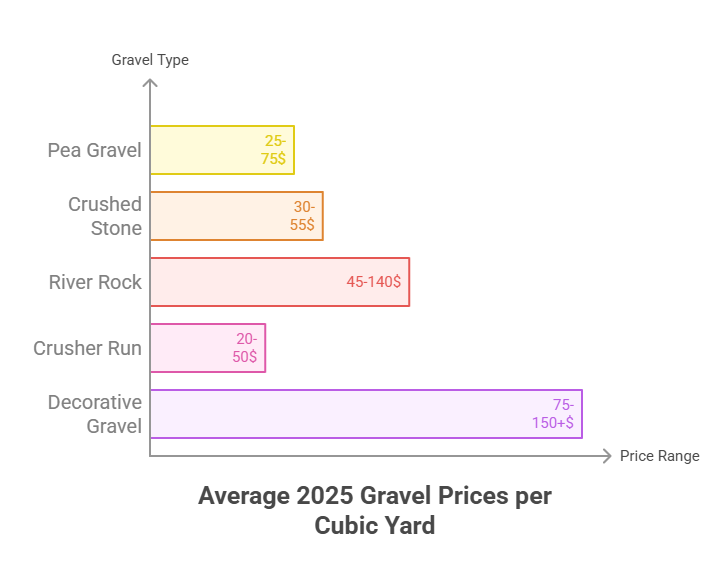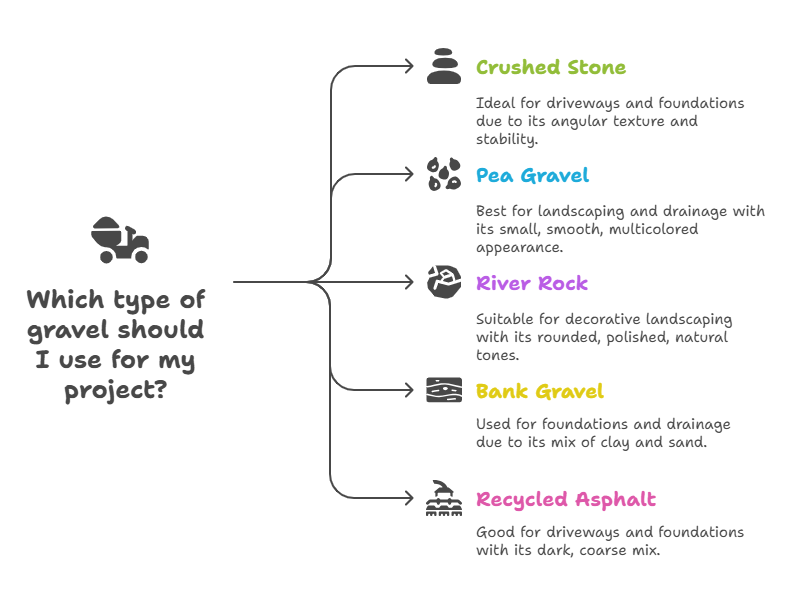If you’re planning a driveway, walkway, or landscaping project, you probably want to know exactly how much a yard of gravel costs. Understanding the price, cost factors, and how to calculate your needs can help you budget smarter and avoid surprise fees. This complete 2025 guide will cover the latest prices, key buying tips, and common questions—helping you get the most from your gravel project.
Gravel remains one of the most affordable and versatile building materials. Whether you’re a homeowner or contractor, knowing the real price per yard is essential for planning, comparing suppliers, and getting the best value.
What Is a Yard of Gravel and What Does It Cover?
A yard of gravel means a cubic yard, which equals a volume that measures 3 feet wide, 3 feet long, and 3 feet deep. This size is a standard way to buy gravel for most home and commercial projects.

One cubic yard of gravel covers about 100 square feet at a 3-inch depth. That’s a typical thickness for driveways and walkways. The weight of a yard of gravel ranges from 2,000 to 3,000 pounds, depending on the rock type and moisture.
When calculating your needs, measure the space you want to fill, and use a gravel calculator to figure out how many cubic yards your project requires.
Read More = How Much Does a Yard of Gravel or Sand Weigh? Complete Weight & Project Planning Guide
Average Cost of a Yard of Gravel in 2025
In the United States, the average price for a yard of gravel ranges from $25 to $100 in 2025. Costs depend on the type of gravel, location, supplier, and delivery fees. Here’s a quick look at average prices by gravel type:
| Gravel Type | Price Per Yard | Best Use Cases |
|---|---|---|
| Pea Gravel | $25–$75 | Paths, patios, playgrounds |
| Crushed Stone | $30–$55 | Driveways, drainage, concrete base |
| River Rock | $45–$140 | Decorative beds, borders, water features |
| Crusher Run | $20–$50 | Heavy-duty driveways, base layers |
| Crushed Limestone | $30–$115 | Roads, general landscaping, construction |
| Decorative Gravel | $75–$150+ | High-end landscaping, accent features |
These ranges include common, well-supplied gravel types. Specialty or colored gravels can cost more.
What Factors Affect the Price of Gravel Per Yard?
Type and Quality of Gravel
Every gravel type comes at a different price. Basic options like pea gravel and crushed stone remain most affordable. Decorative river rock or high-grade stone cost more due to color and source.
Quantity Ordered
Buying more gravel usually lowers the cost per yard. Suppliers often offer bulk discounts for orders above 10 cubic yards. If your project is large, plan ahead and buy in one batch.
Delivery and Location
Delivery costs can increase the total, with average fees ranging from $40 to $100 per load. If you live far from a quarry or urban center, prices are typically higher because of transport.

Supplier and Season
Prices vary by region and supplier competition. Look for seasonal deals or check multiple vendors in your area to find the best price.
DIY versus Professional Installation
Spreading and installing gravel yourself can cut costs. Hiring a pro adds $40–$70 per hour in labor but saves time and ensures a level, long-lasting finish.
Read More = How Much Sand Do I Need? Accurate Calculations for Every Project
How to Calculate How Much Gravel You Need
Start by measuring your project area’s length and width in feet. Decide on the gravel depth needed (2 to 3 inches for most uses). Use this simple formula:
Cubic Yards = (Length in feet × Width in feet × Depth in inches) ÷ 324
For a patio that’s 15 feet by 10 feet and 3 inches deep:
(15 × 10 × 3) ÷ 324 = 1.39 cubic yards
Always round up so you’ll have enough to account for settling or odd shapes.
Top Money-Saving Tips for Buying Gravel
- Order in bulk for better rates if your project needs over 5 yards.
- Choose gravel types supplied locally to avoid high delivery fees.
- Pick up the gravel yourself if you have the right truck and tools.
- Use recycled gravel (like crushed concrete) for base layers to save money.
- Wait for spring or fall when many suppliers offer deals.
- Get multiple quotes before you buy.

Comparing Popular Gravel Types for Projects
Pea gravel is smooth and rounded, perfect for play areas, garden beds, or walking paths. Crushed stone is angular and locks tightly, making it best for driveways and heavy-use surfaces.
River rock looks beautiful in landscaping, borders, or as accents around gardens or ponds. Crusher run and crushed limestone give strong support as road or driveway base layers.
Decorative gravel gives you bold colors and textures but comes with a premium price.
Is Gravel the Best Choice for My Project?
Gravel’s low cost, easy installation, and fast drainage make it a top pick for driveways, patios, paths, and landscape beds. It also works well for French drains and erosion control.
Keep in mind, gravel surfaces need basic upkeep, such as raking or occasional top-ups. Steep slopes or heavy vehicle traffic can lead to shifting, but regular maintenance keeps surfaces looking good.
Read More = What is Gravel: Types, Uses and Complete Construction Guide
Real-Life Example: Driveway Gravel Project
Imagine resurfacing a 30-foot by 12-foot driveway at a 3-inch depth. Calculating your needs:
(30 × 12 × 3) ÷ 324 = 3.33 cubic yards
If you use standard crushed stone at $40 per yard and pay $60 for delivery, your total material cost would be $192. Doing the spreading yourself keeps the overall cost under $200.
Professional vs. DIY Gravel Installation
Buying gravel is only part of the total project cost. Professional installation guarantees proper drainage, grading, and a neat finish. DIY installation saves hundreds but requires time, effort, and the right equipment.
Many choose to tackle spreading small areas, while pros handle large or sloped spaces for a stable base.
Gravel Cost Table for Popular Projects
| Project Type | Gravel Needed (Cubic Yards) | Typical Cost (Materials Only) |
|---|---|---|
| Single-Car Driveway | 3–5 | $75–$275 |
| Patio or Walkway | 2–4 | $50–$200 |
| Garden Beds | 1–3 | $25–$150 |
| Decorative Borders | 1–2 | $30–$170 |
Costs can rise for decorative or colored gravel. Price includes the material only; delivery and labor are extra.
How to Find a Reliable Gravel Supplier
Always check reviews and ask for references. Compare two or three quotes, and confirm delivery times, minimum order amounts, and return policies if you have leftover material.
Local landscaping centers, building suppliers, and large home improvement stores often sell by the yard, and many offer calculators to help measure your needs.For more detail on gravel and aggregates, see the US Geological Survey’s Introduction to Aggregates page.
Frequently Asked Questions
How much does a yard of gravel weigh?
A cubic yard of gravel weighs between 2,000 and 3,000 pounds depending on the type. Denser materials like crushed stone are heavier than lighter varieties such as pea gravel or river rock.
How many square feet does a yard of gravel cover?
A yard of gravel will cover approximately 100 square feet at a 3-inch depth. Adjust coverage downward if you plan on a thicker layer or use larger gravel sizes.
Is it cheaper to buy gravel by the bag or by the yard?
Buying gravel by the yard is more cost-effective for most projects. Bags are convenient for patching or small garden areas but cost much more per yard compared to bulk delivery from landscape yards or quarries.
Does gravel price depend on location?
Yes, prices vary widely depending on proximity to a gravel pit or supplier. Distant or rural areas may pay more, especially for delivery or limited supply.
Read More = Best Rock Calculator
Can I install gravel myself or should I hire a professional?
DIY installation is practical for small projects if you have time and basic tools. For larger jobs, steep slopes, or where drainage is crucial, professional installation ensures longer-lasting results.
What’s the best gravel type for driveways?
Crushed stone or crusher run is usually best for driveways because the angular stone locks together, creating a strong, level surface. Consult with your supplier for local recommendations.
Are recycled gravels like crushed concrete a good option?
Recycled gravel works well for base layers in driveways and paths. It’s cheaper and more sustainable, offering similar strength and drainage as natural stone.
